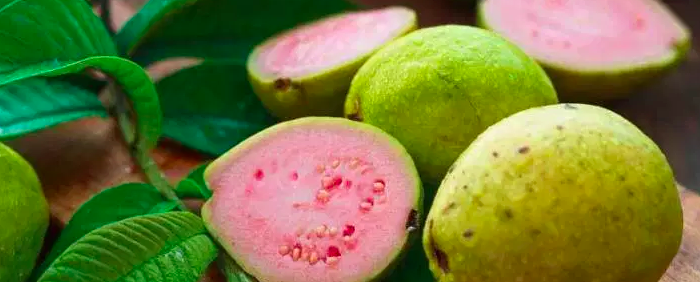
Nutritional value of guava
| Per 100 g | |
| Calories | 68 kcal |
| Water | 81g |
| Carbohydrates | 14.3 g |
| Protein | 2.6g |
| Fat | 0.9 g |
| Dietary fiber | 5.4 g |
| Vitamin C | 228 mg |
| Vitamin A | 31 mg |
| Potassium | 417 mg |
Health Effects of Guava
Antioxidants
The antioxidant content of guava is very interesting. Indeed, several scientific studies have shown that guava has a high content of polyphenols. There are 10 times more in the guava peel than in the flesh 2 . In addition, guava is also an excellent source of vitamin C and contains vitamin A, two vitamins with antioxidant properties. Its vitamin C content is five times higher than orange.
Cholesterol level
In one study, guava consumption increased HDL cholesterol levels, which are beneficial for heart health 3 . On the other hand, this study was carried out with the consumption of approximately 4 guavas per day (400 g) which represents a high consumption and difficult to achieve each day. Guava contains pectin, a soluble fiber known to play a role in blood cholesterol levels 4 .
In addition, guava leaves have a high content of lutein, zeaxanthin and lycopene, nutrients involved in eye health but also in the prevention of certain types of cancer 5 .
Widely used in traditional medicine, guava leaves have astringent and anti-diarrhea properties 6 . Used in decoction or in local application they would also have bactericidal effects. Very ripe guava would have a slightly laxative effect in some people while a very young fruit would have an anti-diarrhea effect. Its crushed flesh has been used for hundreds of years to make moisturizers for the body and face.
Use of guava
When purchasing, look for a smooth, bruised fruit with neither too soft or too hard flesh. Ripe fruit gives off a very fragrant scent. Guavas are usually available from late spring through August in grocery stores. Guava can be kept at room temperature until maturity. It can be placed in a paper bag to speed up the process. Once ripe, it will keep in the fridge for a few days.
Its preparation is simple, guava can be eaten as it is with or without the peel, plain or cooked. You can make it a jam or a jelly. It can be added to sauces, fruit salads, tart, tapioca, ice cream or yogurt. In Mexico, we even mix guava and sweet potato together for an interesting combination. It can also be consumed as juice and in beverages.
A word from the nutritionist
As part of a healthy balanced diet including fruit every day, guava is an interesting choice because of its high content of antioxidants and a good amount of fiber. Do not hesitate to integrate it into your daily life for a tropical and original touch.